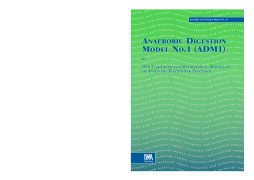
BOOK
Anaerobic Digestion Model No.1 (ADM1)
(2002)
Additional Information
Book Details
Abstract
The IWA Task Group for Mathematical Modelling of Anaerobic Digestion Processes was created with the aim to produce a generic model and common platform for dynamic simulations of a variety of anaerobic processes. This book presents the outcome of this undertaking and is the result of four years collaborative work by a number of international experts from various fields of anaerobic process technology. The purpose of this approach is to provide a unified basis for anaerobic digestion modelling. It is hoped this will promote increased application of modelling and simulation as a tool for research, design, operation and optimisation of anaerobic processes worldwide. This model was developed on the basis of the extensive but often disparate work in modelling and simulation of anaerobic digestion systems over the last twenty years. In developing ADM1, the Task Group have tried to establish common nomenclature, units and model structure, consistent with existing anaerobic modelling literature and the popular activated sludge models (See Activated Sludge Models ASM1, ASM2, ASM2d and ASM3, IWA Publishing, 2000, ISBN: 1900222248). As such, it is intended to promote widespread application of simulation from domestic (wastewater and sludge) treatment systems to specialised industrial applications. Outputs from the model include common process variables such gas flow and composition, pH, separate organic acids, and ammonium. The structure has been devised to encourage specific extensions or modifications where required, but still maintain a common platform. During development the model has been successfully tested on a range of systems from full-scale waste sludge digestion to laboratory-scale thermophilic high-rate UASB reactors. The model structure is presented in a readily applicable matrix format for implementation in many available differential equation solvers. It is expected that the model will be available as part of commercial wastewater simulation packages. ADM1 will be a valuable information source for practising engineers working in water treatment (both domestic and industrial) as well as academic researchers and students in Environmental Engineering and Science, Civil and Sanitary Engineering, Biotechnology, and Chemical and Process Engineering departments. Contents Introduction Nomenclature, State Variables and Expressions Biochemical Processes Physicochemical Processes Model Implementation in a Single Stage CSTR Suggested Biochemical Parameter Values, Sensitivity and Estimation Conclusions References Appendix A: Review of Parameters Appendix B: Supplementary Matrix Information Appendix C: Integration with the ASM Appendix D: Estimating Stoichiometric Coefficients for Fermentation Scientific & Technical Report No.13
Table of Contents
| Section Title | Page | Action | Price |
|---|---|---|---|
| Anaerobic Digestion Model No. 1 | ii | ||
| Acknowledgements | viii | ||
| List of Task Group members | x | ||
| Preface | xii | ||
| Summary | 1 | ||
| 1 Introduction to the ADM1 | 3 | ||
| 1.1 The importance of anaerobic digestion and a generic process model | 3 | ||
| 1.2 Conversion processes in anaerobic digestion | 4 | ||
| 2 Nomenclature, state variables and expressions | 6 | ||
| 2.1 Units | 6 | ||
| 2.2 Nomenclature and description of parameters and variables | 7 | ||
| 2.3 Dynamic state variables | 8 | ||
| 3 Biochemical processes | 9 | ||
| 3.1 Structure of biochemical reactions in the ADM1 | 9 | ||
| 3.2 Rate equation matrix | 12 | ||
| 3.3 Disintegration and hydrolysis | 13 | ||
| 3.3.1 Kinetics of disintegration and hydrolysis | 14 | ||
| 3.4 Mixed product acidogenesis | 14 | ||
| 3.4.1 Acidogenesis from monosaccharides | 15 | ||
| 3.4.2 Acidogenesis from amino acids | 17 | ||
| 3.5 Syntrophic hydrogen-producing acidogenesis and hydrogen-utilising methanogenesis | 18 | ||
| 3.5.1 Form of electron carrier | 20 | ||
| 3.5.2 Biological groups and components in the ADM1 | 21 | ||
| 3.5.3 Hydrogen inhibition functions for acetogenesis | 21 | ||
| 3.6 Aceticlastic methanogenesis | 23 | ||
| 3.7 Inhibition and toxicity | 23 | ||
| 3.7.1 Modelling of inhibition | 25 | ||
| 3.8 Influence of temperature | 28 | ||
| 3.8.1 Modelling of temperature effect on disintegration and hydrolysis | 30 | ||
| 3.8.2 Effect of temperature on thermodynamic yields and reaction pathways | 31 | ||
| 4 Physico-chemical processes | 33 | ||
| 4.1 Liquid–liquid processes | 34 | ||
| 4.1.1 Modelling of acid-base reactions | 34 | ||
| 4.2 Liquid–gas transfer | 37 | ||
| 4.2.1 Liquid–gas transfer equations | 37 | ||
| 4.3 Variation of physico-chemical parameters with temperature | 38 | ||
| 5 Model implementation in a single stage CSTR | 40 | ||
| 5.1 Liquid phase equations | 41 | ||
| 5.2 Gas phase equations | 42 | ||
| 5.3 Specific example: inorganic carbon | 43 | ||
| 5.3.1 DAE system | 43 | ||
| 5.3.2 DE system | 44 | ||
| 6 Suggested biochemical parameter values, sensitivity and estimation | 45 | ||
| 6.1 Hydrolysis parameters | 46 | ||
| 6.1.1 Parameters associated with propionate | 48 | ||
| 6.1.2 Parameters associated with acetate | 48 | ||
| 7 Conclusion | 49 | ||
| References | 51 | ||
| Appendix A: A review of parameters | 56 | ||
| Appendix B: Supplementary matrix information | 63 | ||
| Appendix C: Integration with the ASM | 68 | ||
| Appendix D: Estimating stoichiometric coefficients for fermentation | 72 | ||
| Index | 75 |
